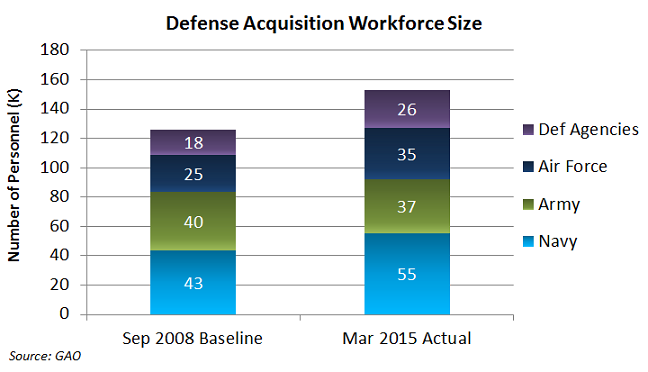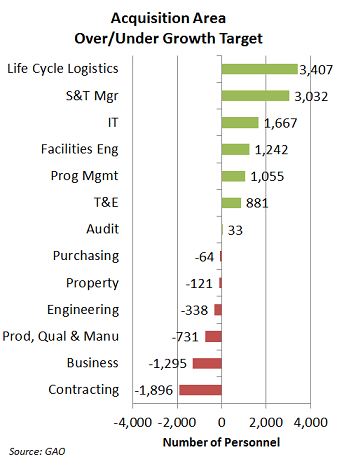Defense Acquisition Workforce – Overall Growth, but Key Areas Lag
Published: December 16, 2015
Acquisition ReformUSAFARMYDEFENSENAVY
The Department of Defense (DoD) has added more than 25,000 acquisition workforce personnel in the last 7 years, but not all branches have made gains and not all high-priority functional areas have met their hiring targets.
The DoD has long recognized that it needs to take steps to ensure that they have an adequately sized and capable acquisition workforce to acquire roughly $300 billion in goods and services each fiscal year (FY). A recent study by the Government Accountability Office (GAO) determined that DoD has made progress in some, but not all, areas.
DoD Acquisition Workforce (DAW)
The DoD exceeded its 20,000 personnel growth target from September 2008 to March 2015 by over 7,000. GAO found that most of the growth occurred in FYs 2009 and 2010. In FYs 2013 and 2014, DoD experienced a small decrease as components were faced with sequestration and other cost-cutting measures. The total DAW grew 26,772 from 125,879 to 152,651 – a 21% growth overall. (See chart below.)

Key GAO findings on DoD acquisition workforce include:
- 72% (17,633) of the growth came from new civilian hires. 14% (3,400) and 3% (712) of the growth came from insourcing and from additional military positions, respectively. The remaining 11% growth came through administrative recording efforts.
- The Air Force, Navy, and DoD agencies have more acquisition personnel now than in FY 2008, growing 40%, 27%, and 47% respectively. The Army shows an 8% decrease in the size of its acquisition workforce over the same years due to Army-wide cost savings measures that have impacted the size of the civilian workforce.
The DoD’s 2010 acquisition workforce plan identified growth goals for each of the 13 acquisition career fields—contracting; business; production, quality and manufacturing; engineering; property; purchasing; audit; test and evaluation; program management; facilities engineering; information technology; science and technology manager; life cycle logistics. While the overall growth goal was met, key strategic priority area goals were not met. (See chart below.)

The 2010 plan indicated that targeted growth in 5 priority career fields—auditing, business, contracting, engineering, and program management—would help DoD strategically reshape its acquisition workforce. DoD missed 3 of these 5 goals. The business category was divided into two career fields in 2010, cost estimating and financial management. The two career fields are reported under “business” for consistency.
Implications
Twenty-six percent of the approximately 2,700 personnel that DoD hired over the past 7 years were in career fields that were not considered high priority in the 2010 acquisition workforce plan. GAO noted that without an updated and revised plan DoD runs the risk of hiring people in areas that exceed their targets or are not considered a priority. This means that acquisitions that depend on the lagging hiring areas may experience issues that could negatively impact both the requirements and effectiveness of the competition. This has clear implications for contractors competing for these contracts, potentially raising proposal costs and impacting overall program schedules and performance. It also could indicate sustained demand for contracted support services in the lagging areas, so the missed and over-achieved goals can cut both ways.